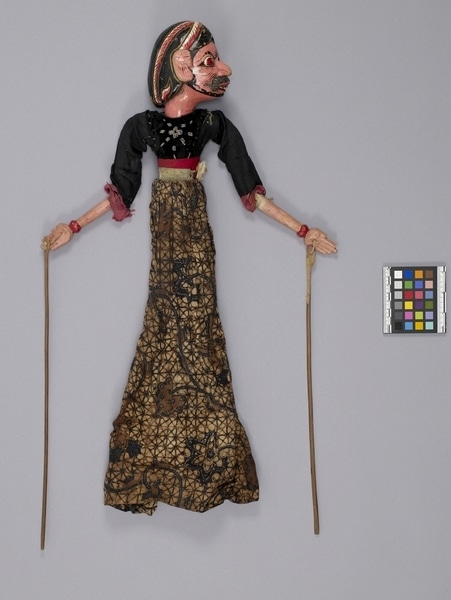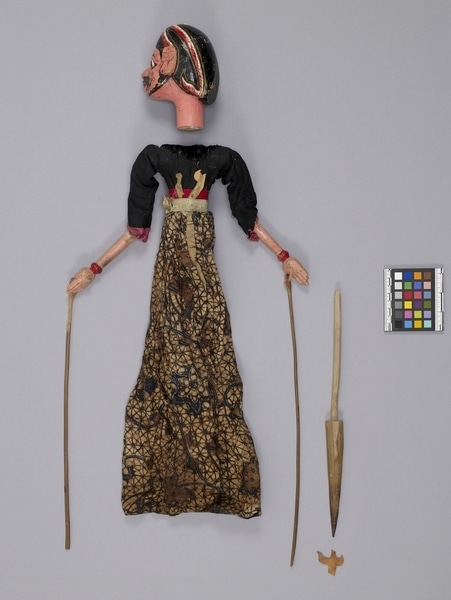Rod Puppet Item Number: Ib297 a-d from the MOA: University of British Columbia


Description
Three-dimensional male humanoid puppet: large head (part b) fits into body with skirt (part a), and a control rod (part d) with a long shaft that passes through the body and fits into the neck of the figure's head. The body has jointed arms, each with a long controlling rod attached. Two wooden dagger-like pieces placed under waist band at back. One fragment (part c) of a dagger has broken off. The figure has a pink face with black hair and beard, and a painted ribbon crossing at the top of his head. Bulging red iris in each eye with black pupils. Black bushy moustache curving down at mouth corners. Protruding teeth from upper jaw. The figure is wearing a black tunic with sleeves to mid-arm with beading on the front, and a brown, light brown, black batik skirt.
History Of Use
Javanese puppetry as an art form probably developed by the 11th century. The three-dimensional wooden wayang golek puppets of western Java, which are to be distinguished from the earlier and more sacred wayang kulit shadow plays puppets or other forms, appeared during the 16th century. Originally the plays depicted Javanese mythology, but after the Indian conquest of Java the Hindu epics, Ramayana and Mahabharata, were incorporated into the cycles, which comprise about 200 plays. An individual or group hires a dalang (puppet-master) to celebrate important occasions. The performances often last all night and are generally presented in three acts, with vocal and instrumental accompaniment. The individual plays vary widely in detail but usually involve conflict between good and evil. They serve a moral and religious purpose, and more recently, one of political commentary. Each puppet's character is represented by its appearance and placement onstage; protagonists with strong elements of good are placed to the right, antagonists of violent or evil nature to the left. Kartamarna is one of the Kurawa brothers who are the main antagonists in the Mahabharata cycle; they are in constant and futile conflict with the good Pandawa brothers, their cousins and childhood companions. The Pandawas are noted for their honour and unswerving unity in action; the Kurawas, who outnumber them, for their ill temper, rash violence, and disunity.
Cultural Context
Theatrical performance.
Iconographic Meaning
Red face denotes anger and hostile nature. Extended teeth a negative trait associated with ogres and other evil entities. Red eyes are also considered evil. However, other features indicate a certain refinement, such as the well-kept beard, fine clothing and elaborate headdress that are commonly found on characters of noble or deific stature. Batik skirt also indicative of wealth. Extended fingers, wrist bracelet, linked to nobility. Character portrayed is Kartamarna, one of the evil Kurawa brothers.
Item History
- Made in Java, Indonesia
- Owned by Tradewind Antiques before March 15, 1983
- Received from Museum of Anthropology Shop Volunteers (Funding source) and Tradewind Antiques (Seller) on March 15, 1983
What
Who
- Culture
- Sundanese
- Previous Owner
- Tradewind Antiques
- Received from
- Museum of Anthropology Shop Volunteers (Funding source) and Tradewind Antiques (Seller)
Where
- Holding Institution
- MOA: University of British Columbia
- Made in
- Java, Indonesia
When
- Ownership Date
- before March 15, 1983
- Acquisition Date
- on March 15, 1983
Other
- Condition
- fair
- Accession Number
- 0886/0031 a-d